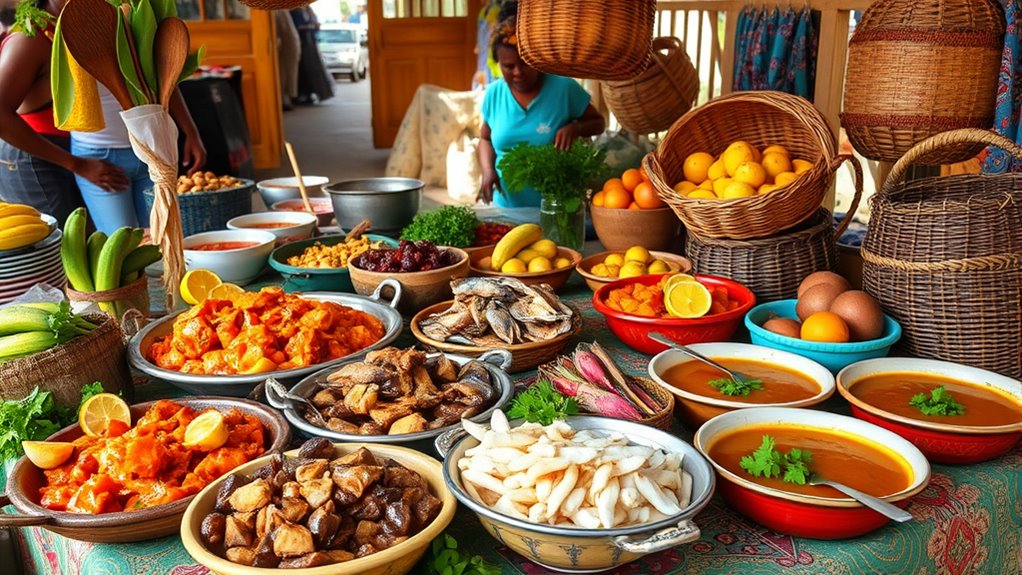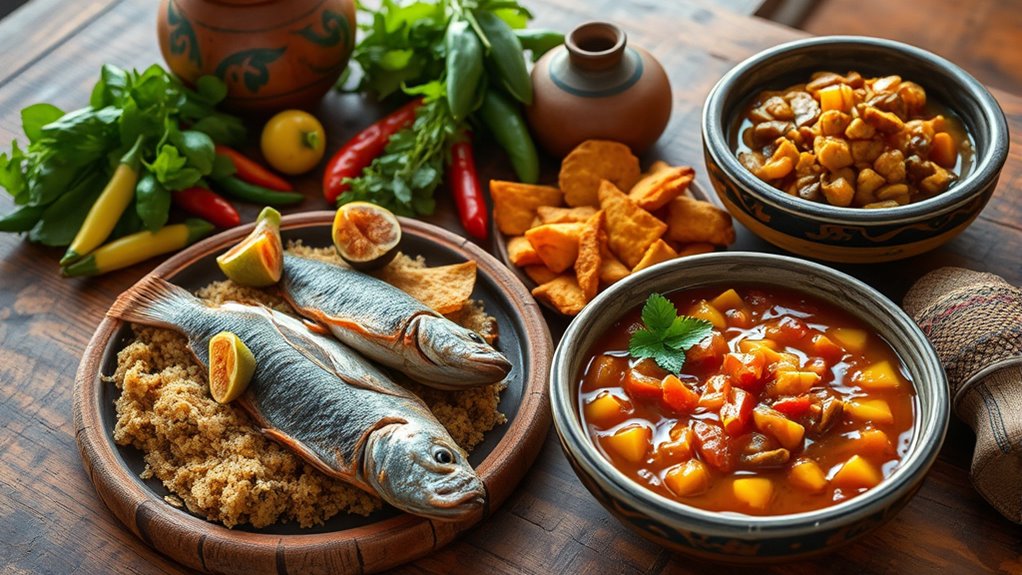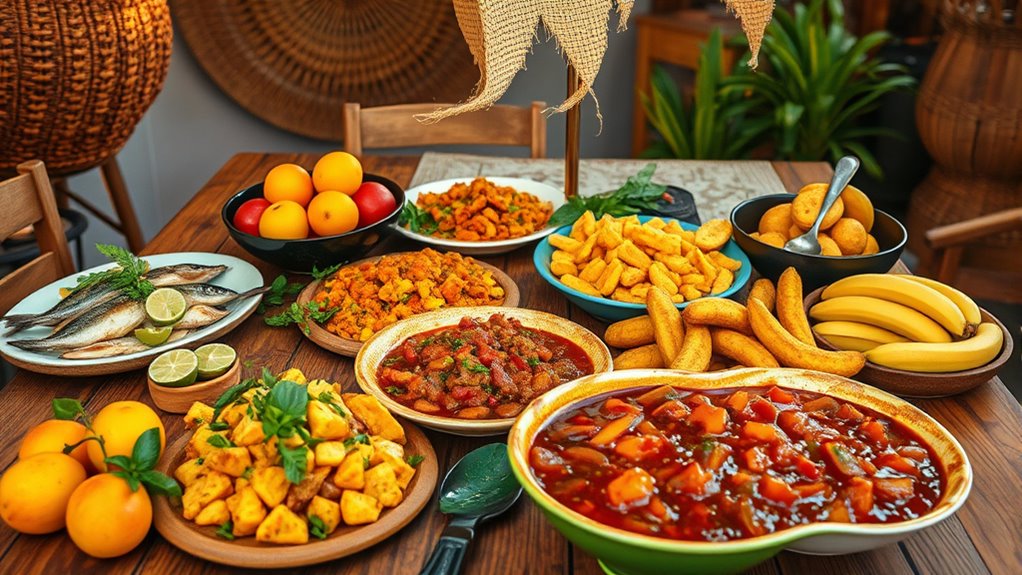St. Lucia’s cuisine blends French, British, and East Indian influences, creating vibrant flavors through spices, herbs, and diverse ingredients. You’ll find traditional dishes like green figs and saltfish, breadfruit, and hearty stews that showcase local produce and seafood. Celebratory foods, such as sorrel drink and Pemmie, highlight cultural festivities. The cooking techniques and community traditions reflect resourcefulness and history. To discover more about these delicious traditions, keep exploring the island’s culinary story.
Key Takeaways
- St. Lucian cuisine features a Creole blend of French, British, and East Indian flavors with aromatic spices and fresh herbs.
- Key ingredients include saltfish, green bananas, breadfruit, yams, and seafood, reflecting local resources.
- Traditional dishes like green figs and saltfish, bouyon, and pemmie are central to cultural celebrations.
- Cooking techniques involve boiling, frying, roasting, and stewing, showcasing resourcefulness and diverse methods.
- Food plays a vital role in community bonding and preserving cultural heritage through shared meals and special occasion dishes.
Cultural Influences Shaping St. Lucian Flavors

St. Lucia’s cuisine is shaped by a rich blend of cultural influences. You’ll notice French, British, and East Indian flavors woven into every dish, reflecting the island’s colonial history and indentured labor. These influences come together in the use of spices, herbs, and cooking techniques, creating a vibrant Creole flavor profile. You might taste the aromatic cinnamon and cloves alongside fresh parsley and thyme, which add depth to local recipes. The history of necessity also influenced the cuisine, leading you to find simple ingredients like green bananas, breadfruit, and saltfish at the heart of many traditional dishes. This fusion of cultures results in a unique culinary identity that celebrates both the island’s diverse heritage and its resourcefulness. Incorporating diverse ingredients and creative cooking methods further enhances the vibrant flavors found throughout St. Lucia’s culinary landscape.
Iconic Traditional Dishes and Local Ingredients

Many of the island’s most iconic dishes showcase a vibrant use of local ingredients like green bananas, breadfruit, and saltfish. You’ll find green figs and saltfish as the national dish, combining salted cod with boiled green bananas for a hearty, comforting meal. Breadfruit is another staple, prepared by boiling, roasting, or frying to serve as a versatile side or main. Ground provisions such as yams and sweet potatoes add richness to stews and soups. Fresh herbs like thyme and parsley boost flavor, while seafood, especially saltfish and fresh fish, is essential in many recipes. These ingredients highlight the resourcefulness of St. Lucian cuisine, blending local produce with traditional techniques to create bold, flavorful dishes that reflect the island’s cultural roots. Incorporating traditional cooking methods like smoking and fermenting further enriches the island’s culinary heritage.
Celebratory Foods and Special Occasion Delights

Celebratory foods and special occasion treats hold a prominent place in St. Lucia’s vibrant culture. When celebrating, you’ll find these dishes bring people together and honor traditions. For example:
Celebratory foods in St. Lucia unite communities and honor cherished traditions.
- Pemmie – A sweet, comforting dish made with cornmeal, pumpkin, and coconut, often enjoyed during Creole Heritage Month.
- Sorrel Drink – A festive, spicy beverage made from sorrel flowers, popular at Christmas and New Year’s celebrations.
- Green Figs and Saltfish – A festival favorite during Creole Day (Jounen Kweyol), symbolizing national pride.
- Bouyon – A hearty, flavorful soup served at family gatherings and special events.
These foods are more than just dishes; they’re expressions of community, history, and celebration in St. Lucia.
Cooking Techniques and Methods Unique to the Island

The rich flavors of St. Lucia come alive through unique cooking techniques that reflect the island’s history and environment. You’ll find boiling and steaming are essential for preparing green bananas and breadfruit, preserving their natural flavors. Frying is popular for making crispy bakes and plantains, adding texture and taste. Roasting breadfruit enhances its smoky aroma, while stewing saltfish develops deep, savory notes. Grilling is common during outdoor gatherings, especially for pork and seafood, imparting a charred flavor. Here’s a quick overview:
| Technique | Typical Use |
|---|---|
| Boiling/Steaming | Green bananas, breadfruit |
| Frying | Bakes, plantains |
| Grilling | Meats, seafood during celebrations |
These methods create bold flavors and traditional textures you’ll love to recreate. Cooking techniques play a vital role in capturing the authentic taste of St. Lucia’s cuisine.
The Cultural Significance and Community Role of Food

Food in St. Lucia holds deep cultural significance and plays a essential community role. It’s more than sustenance; it’s a way to connect, celebrate, and preserve traditions. When you gather for a family event or festival, shared dishes like green figs and saltfish bring everyone together, fostering bonds. These meals reflect your island’s history, blending French, British, and East Indian influences, creating a unique Creole identity. Food also acts as a symbol of pride and resilience, passing from generation to generation. Additionally, local ingredients support the economy and promote sustainability. Recognizing the importance of culinary heritage helps sustain traditional recipes and farming practices for future generations. Whether during holidays, festivals, or everyday life, food unites communities and keeps cultural heritage alive. Here’s what makes this role so impactful:
Food in St. Lucia unites communities, preserves traditions, and reflects a rich blend of cultural influences.
- Celebrations and festivals
- Family and community bonding
- Cultural preservation
- Economic and social cohesion
Frequently Asked Questions
How Has Tourism Influenced the Evolution of St. Lucian Cuisine?
Tourism has shaped your culinary experience by encouraging local chefs to showcase authentic St. Lucian dishes, often adding modern twists to appeal to visitors. You’ll find more restaurants emphasizing traditional flavors, using fresh ingredients to attract tourists seeking cultural authenticity. Additionally, festivals and food events inspired by tourism promote local recipes to a broader audience, helping preserve heritage while adapting to global tastes and boosting the island’s culinary reputation.
Are There Any Unique Street Foods Specific to St. Lucia?
You’ll find that street foods like Accra, a fried saltfish snack, are uniquely St. Lucian and beloved during festivals. Nearly 60% of locals enjoy these quick bites daily, highlighting their cultural importance. You can also try fried plantains and breadfruit chips, which are common on busy street corners. These foods offer an authentic taste of the island’s flavors, connecting you to its vibrant traditions and community spirit.
What Role Do Traditional Cooking Utensils Play in Local Culinary Practices?
You’ll find traditional cooking utensils are essential in St. Lucian culinary practices. They help you prepare authentic dishes like bouyon or callaloo soup by ensuring proper cooking techniques. Using tools like wooden spoons, clay pots, and grinding stones connects you to cultural heritage and enhances flavors. These utensils make your cooking more authentic, preserving traditions passed down through generations, and foster community bonding during meal preparations and celebrations.
How Do Regional Differences Within St. Lucia Affect Food Preparation?
You’ll notice regional differences in St. Lucia influence how you prepare food. In coastal areas, you might focus on fresh seafood, grilling or steaming it for ideal flavor. Inland, you’ll find more use of ground provisions like yams and sweet potatoes, often stewed or boiled. These local variations shape your cooking methods, reflecting the island’s diverse landscapes and resources, making each region uniquely flavorful and traditional.
Are There Specific Dietary Restrictions or Customs Associated With St. Lucian Food?
You might not expect it, but traditional St. Lucian food has few strict dietary restrictions, reflecting its cultural diversity. Instead, customs emphasize sharing and celebration through dishes like green figs and saltfish, eaten during festivals and family gatherings. While some avoid pork for religious reasons, most dishes are inclusive, highlighting fresh seafood and local produce. The focus remains on community, tradition, and honoring local ingredients rather than strict dietary rules.
Conclusion
As you embrace the flavors of St. Lucia, you step into a vibrant tapestry woven with history and community, much like a storyteller passing down cherished tales. Each bite echoes the island’s rich cultural soul, reminding you that food here isn’t just sustenance—it’s a celebration of life, unity, and tradition. Just as the sun sets over the Caribbean Sea, the island’s culinary heritage lingers, inviting you to savor its timeless beauty and spirit.










